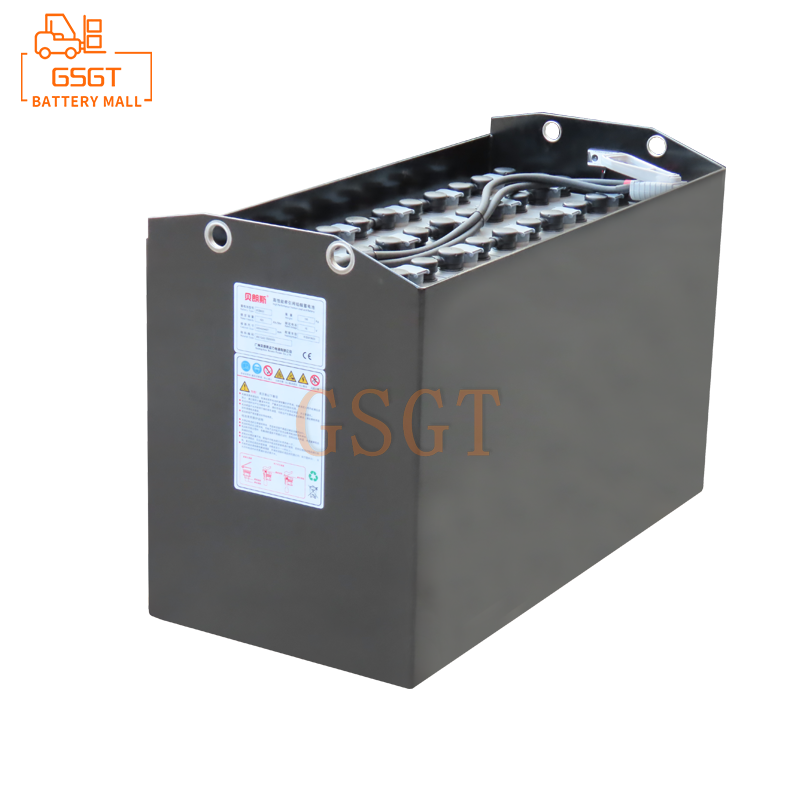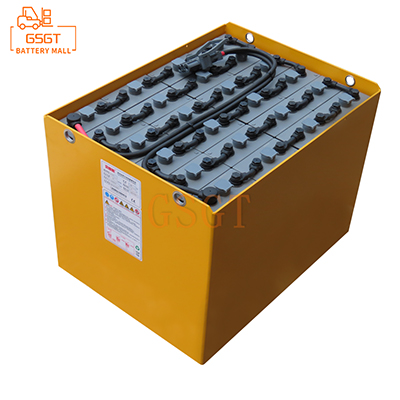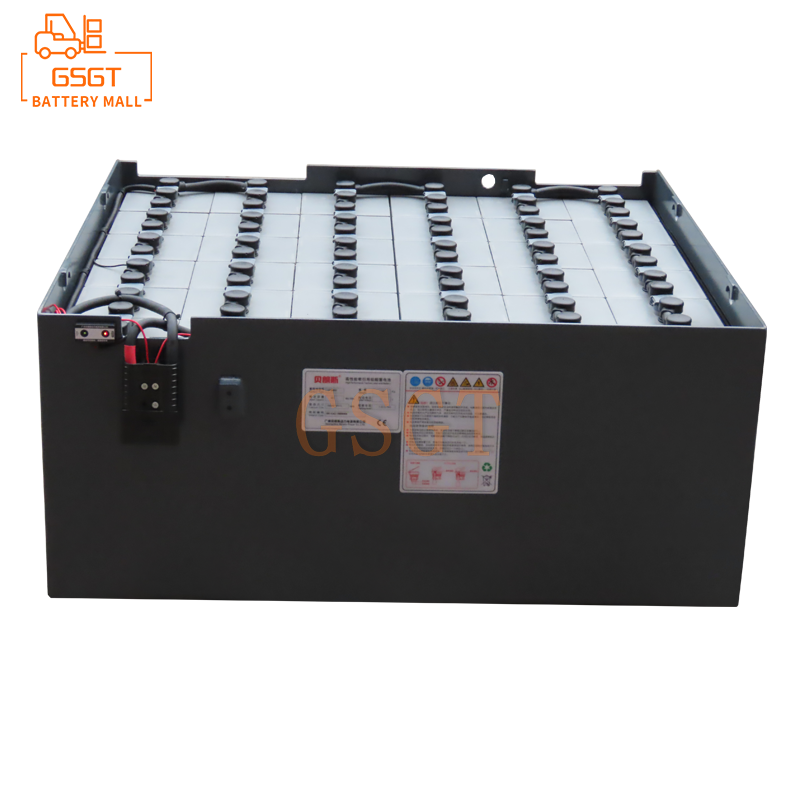Time:2025-04-29 10:56:13
Browse:630
Introduction
In the modern logistics and warehousing field, forklifts, as key material handling equipment, their efficient and stable operation plays a decisive role in the smoothness of the entire warehousing operation process. And the power source of forklifts - the battery - is the core element among them. Lead-acid batteries, with their unique performance characteristics, occupy an important position in the application of logistics and warehousing forklifts. An in-depth exploration of the application of lead-acid batteries for forklifts in logistics and warehousing holds profound significance for enhancing the efficiency of warehousing operations, reducing operating costs, and promoting the sustainable development of the industry.
The working principle and performance characteristics of lead-acid batteries
Working principle
The operation of lead-acid batteries is based on electrochemical principles. Its interior is mainly composed of positive plates, negative plates, electrolyte and separators, etc. The active material of the positive plate is usually lead dioxide, while that of the negative plate is spongy lead. The electrolyte is generally a dilute sulfuric acid solution. During the discharge process, lead dioxide on the positive plate reacts with sulfuric acid in the electrolyte to form lead sulfate and release electrons. The electrons flow through the external circuit to the negative electrode, generating a current. The lead on the negative plate also reacts with sulfuric acid to form lead sulfate. During charging, the process is the opposite. Under the action of an external power supply, lead sulfate is respectively re-converted into lead dioxide and lead on the positive and negative plates, and the concentration of sulfuric acid in the electrolyte gradually recovers.
Performance characteristics
High energy density: Lead-acid batteries can store a large amount of electrical energy in a relatively small volume and weight. This enables forklifts equipped with lead-acid batteries to have sufficient power to handle heavy goods, meeting the basic power requirements for forklifts in logistics and warehousing. For instance, the common lead-acid batteries used in forklifts can provide continuous power output for several hours, enabling forklifts to complete a series of loading, unloading and handling tasks.
Cost-benefit advantage: Compared with other types of batteries such as lithium-ion batteries, lead-acid batteries have a lower manufacturing cost. This enables enterprises to reduce their initial investment costs when forklifts are widely applied in logistics and warehousing on a large scale. For some logistics and warehousing enterprises with limited budgets but in need of a large number of forklift equipment, the cost advantage of lead-acid batteries is particularly prominent. Meanwhile, lead-acid batteries have a relatively high recycling value. The lead and other materials inside them can be effectively recycled and reused, further reducing the cost of use.
Good low-temperature performance: In the logistics and warehousing environment, some warehouses may be in a low-temperature state, especially some refrigerated and frozen warehouses. Lead-acid batteries can still maintain certain performance in low-temperature environments and can provide the power needed for the start-up and operation of forklifts. Although its performance will decline as the temperature drops, compared with some battery types that are more sensitive to temperature, lead-acid batteries have stronger adaptability in low-temperature environments and can ensure the normal operation of forklifts in low-temperature storage conditions.
High safety: The technology of lead-acid batteries is mature, and the chemical reactions inside are relatively stable. Under normal usage and maintenance conditions, the probability of serious safety accidents such as explosions and fires is relatively low. This is of vital importance for logistics and warehousing sites with a high concentration of people and goods. A stable and reliable power source can ensure the safe operation of warehousing and reduce potential safety hazards caused by battery failures.
Application scenarios of lead-acid batteries for forklifts in logistics and warehousing
Goods handling inside the warehouse
In large logistics warehouses, forklifts need to frequently move goods from the receiving area to the storage area, or from the storage area to the shipping area. Lead-acid batteries for forklifts provide stable power for the forklifts, enabling them to move flexibly through the narrow passageways inside the warehouse and accurately place goods in the designated positions. Whether it is the handling of palletized goods or loose goods
Shelf access operation
Modern logistics and warehousing warehouses often adopt high-rise shelf storage methods to improve space utilization. Forklifts need to have sufficient power and stability to complete the storage and retrieval operations between shelves. The high energy output characteristic of lead-acid batteries enables forklifts to easily lift goods to higher shelf positions for storage or remove goods from the shelves. Moreover, lead-acid batteries perform stably during long-term low-power output, which can meet the power demands of forklifts for slow and precise movement operations in the shelf area, ensuring the efficiency and safety of shelf storage and retrieval operations.
Cold chain logistics warehousing
Cold chain logistics and warehousing have extremely strict requirements for temperature control, and the operational performance of forklifts in low-temperature environments is of vital importance. As mentioned earlier, lead-acid batteries have relatively good low-temperature performance and can adapt to the low-temperature environment in cold chain warehouses, providing continuous and stable power for forklifts. In refrigerated or frozen warehouses, forklifts driven by lead-acid batteries can normally complete the handling and loading/unloading of goods, ensuring the smooth operation of cold chain logistics and guaranteeing the timely delivery of perishable foods, medicines and other goods in low-temperature environments.
The advantages of lead-acid batteries for forklifts in logistics and warehousing
The initial investment cost is low
For logistics and warehousing enterprises, purchasing a large number of forklift equipment requires a huge investment of funds. The relatively low cost of lead-acid batteries enables enterprises to save a significant amount of money in the initial investment of forklift power systems. Compared with other battery types such as lithium-ion batteries that are more expensive, lead-acid batteries enable enterprises to purchase a greater number of forklifts within a limited budget, thereby expanding the scale of warehousing operations and enhancing logistics processing capacity.
The technology is mature and highly reliable
After long-term development and application, lead-acid battery technology has become quite mature. In the field of logistics and warehousing, its reliability has been widely verified. During the high-intensity operation of forklifts, lead-acid batteries can stably output power and rarely experience sudden power outages and other faults. Even in some harsh working environments, such as vibrations caused by uneven warehouse floors, lead-acid batteries can maintain a normal working state thanks to their robust and durable structure. This enables logistics and warehousing enterprises to not worry too much about forklift shutdowns caused by battery failures, which in turn affect the entire warehousing operation process, ensuring the continuity and stability of logistics operations.
Strong compatibility
At present, most forklifts on the market take compatibility with lead-acid batteries into consideration from the very beginning of their design. This means that logistics and warehousing enterprises do not need to worry about the compatibility between forklifts and batteries when choosing them. Whether it is a traditional internal combustion forklift converted to an electric forklift or a newly purchased electric forklift, lead-acid batteries can be well matched with them. Moreover, the specifications and models of lead-acid batteries are relatively uniform. When replacing or expanding batteries, enterprises can conveniently obtain suitable products, reducing the difficulty of equipment maintenance and management.
It has a high recycling value
Lead in lead-acid batteries is a metal with relatively high recycling value. After the battery's service life comes to an end, through professional recycling and processing, the lead and other materials within it can be effectively recycled and reused. This not only reduces pollution to the environment, but also brings certain economic benefits to enterprises. Logistics and warehousing enterprises can cooperate with professional battery recycling enterprises to recycle and process used lead-acid batteries, obtain corresponding recycling funds, thereby reducing the usage cost of batteries to a certain extent. At the same time, it also fulfills the social responsibility of enterprises and promotes the sustainable development of the industry.
Challenges faced by lead-acid batteries for forklifts in logistics and warehousing
The cruising range and service life are limited
With the continuous increase in the volume of logistics and warehousing business, forklifts need to operate continuously for long periods of time. However, the driving range of lead-acid batteries is relatively short. After a full charge, the working time of a forklift usually ranges from several hours to over ten hours. This may require frequent charging in some high-intensity and long-duration logistics and warehousing scenarios, which could affect operational efficiency. In addition, the service life of lead-acid batteries is generally around 1,500 charge and discharge cycles, which is relatively shorter than that of other new types of batteries. Frequent battery replacement not only increases the operating costs of enterprises, but also leads to an increase in forklift downtime, affecting the normal operation of logistics.
Long charging time
The charging speed of lead-acid batteries is relatively slow. With conventional charging methods, it usually takes 8 to 10 hours to fully charge the battery. This means that after the forklift's battery runs out, it will take a relatively long time to wait before it can be put back into use. During the peak period of logistics and warehousing operations, the frequent use of forklifts makes charging time a key factor restricting operational efficiency. Although fast charging technology can be adopted, it has high requirements for charging equipment and may shorten the battery's service life and increase the cost of use.
The maintenance requirements are relatively high
To ensure the performance and service life of lead-acid batteries, regular maintenance is required. Maintenance work includes checking the electrolyte level and density, performing equalization charging, and cleaning the battery surface, etc. These maintenance tasks not only require professional technicians to operate, but are also rather cumbersome, consuming certain time and human resource costs.
Environmental protection pressure
Lead-acid batteries pose certain environmental pollution risks during their production and recycling processes. Lead is a heavy metal. If it is not properly managed during the production process, it may lead to lead pollution, causing harm to the environment and human health. During the battery recycling process, if not handled properly, lead and acidic electrolyte in the batteries may leak, polluting the soil and water sources. With increasingly strict environmental protection requirements, logistics and warehousing enterprises need to assume greater environmental responsibilities when using lead-acid batteries, take effective environmental protection measures, and ensure that the production, use and recycling processes of lead-acid batteries comply with environmental protection standards. This undoubtedly increases the operating costs and management difficulties of enterprises.
Strategies for addressing challenges and future development directions
Strategies for dealing with challenges
Adopt new charging technologies: Research and apply new charging technologies, such as intelligent charging technology and wireless charging technology, to shorten the charging time of lead-acid batteries. Intelligent charging technology can automatically adjust the charging voltage and current according to the real-time status of the battery, achieving fast and safe charging. Wireless charging technology can avoid the cumbersome operation of plugging and unplugging the charging plug in the traditional charging method, improve the convenience of charging, and at the same time reduce the wear and tear and failure of the charging interface.
Strengthen maintenance management: Establish a complete maintenance management system for lead-acid batteries and conduct regular comprehensive inspections and maintenance of the batteries. Train professional maintenance personnel, enhance their maintenance skills and proficiency, and ensure the quality of maintenance work. Advanced detection equipment, such as battery internal resistance testers and capacity detectors, is adopted to promptly identify potential problems with batteries and carry out targeted handling. In addition, maintenance files can be established to record the maintenance history and performance changes of the battery, providing a basis for battery replacement and management.
Promote environmentally friendly production and recycling: In the production process of lead-acid batteries, enterprises should adopt advanced production techniques and environmental protection equipment to reduce the generation of lead pollution. Strengthen the management of the production process to ensure that all environmental protection indicators meet national standards. In the battery recycling process, establish a standardized recycling system and cooperate with professional recycling enterprises to ensure that used lead-acid batteries are properly recycled and processed. Through technological innovation, the recycling rate of lead-acid batteries can be enhanced to reduce their harm to the environment.
Future development direction
Technological innovation enhances performance: In the future, lead-acid battery technology will continue to innovate. By improving battery materials and optimizing battery structures, the energy density, driving range and service life of batteries will be increased. For example, develop new types of lead alloy materials to enhance the corrosion resistance and electrical conductivity of battery plates; Adopting a new electrolyte formula, the charging and discharging efficiency of the battery is enhanced. At the same time, efforts should be made to enhance the research on battery thermal management technology, improve the performance of batteries in different temperature environments, and expand the application scenarios of lead-acid batteries in logistics and warehousing.
Conclusion
Lead-acid batteries for forklifts currently play a significant role in the logistics and warehousing field. Their advantages such as cost-effectiveness, technological maturity, compatibility, and recycling value make them an important choice for the power of forklifts in logistics and warehousing. However, it also faces numerous challenges such as limited driving range and service life, long charging time, high maintenance requirements, and environmental protection pressure. These challenges can be effectively addressed by adopting strategies such as optimizing the battery management system, adopting new charging technologies, strengthening maintenance management, and promoting environmentally friendly production and recycling.

$2450

$3405

$4045

$2140

MESSAGE
Professional And Efficient
Security
Affordable Price
Professional Services